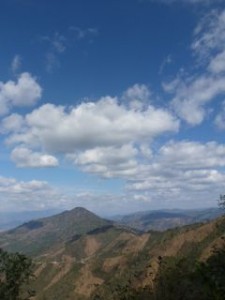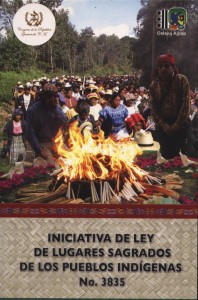
ಮೊದಲು ಸೈನ್ 2012 ಪವಿತ್ರ ನೈಸರ್ಗಿಕ ತಾಣಗಳ ಉಪಕ್ರಮವು ಆಧ್ಯಾತ್ಮಿಕ ನಾಯಕರ ಗ್ವಾಟೆಮಾಲನ್ ಮಾಯನ್ ಸಮ್ಮೇಳನಕ್ಕೆ ಭೇಟಿ ನೀಡಿತು, Oxlajuj Ajpop. ಲಾರಿಯ ಹಿಂಭಾಗದಲ್ಲಿ ದೀರ್ಘ ಸವಾರಿಯ ಸಮಯದಲ್ಲಿ, Oxlajuj Ajpop ನ ನಿರ್ದೇಶಕ ಫೆಲಿಪೆ ಗೊಮೆಜ್, ಮಾಯನ್ ಜನರು ಪ್ರಸ್ತುತ ಸಂಪನ್ಮೂಲ ಅಭಿವೃದ್ಧಿ ಮತ್ತು ಧಾರ್ಮಿಕ ಗುಂಪುಗಳಿಂದ ಹೆಚ್ಚು ಬೆದರಿಕೆಗೆ ಒಳಗಾಗಿರುವ ಪೂರ್ವಜರ ಪವಿತ್ರ ನೈಸರ್ಗಿಕ ತಾಣಗಳ ಜಾಲವನ್ನು ಪುನಃಸ್ಥಾಪಿಸಲು ಹೇಗೆ ಹೆಣಗಾಡುತ್ತಿದ್ದಾರೆ ಎಂಬುದನ್ನು ವಿವರಿಸುತ್ತಾರೆ..

ಸಿಗರ್ಬ್-ಅಲ್ ಚು, ವಾಯುವ್ಯ ಗ್ವಾಟೆಮಾಲಾದಲ್ಲಿ, ಪಾಪುಲ್ ವುಹ್ನಲ್ಲಿ ಸೂರ್ಯನ ಜಾಗೃತಿಯ ಸ್ಥಳವೆಂದು ವಿವರಿಸಿರುವ ಮಾಯಾಗೆ ಪವಿತ್ರ ಪರ್ವತವಾಗಿದೆ. ಫೋಟೋ: ಬಾಸ್ Verschuuren.
ನಾವು ಚು ಸಗ್ರಿಬಲ್ಗೆ ಹೋಗುವ ದಾರಿಯಲ್ಲಿದ್ದೇವೆ, ಪಾಪುಲ್ ವುಹ್ ನಲ್ಲಿ ವಿವರಿಸಲಾದ ಪುರಾತನ ಪವಿತ್ರ ಪರ್ವತ – ಮಾಯಾಗಳ ಪ್ರಾಚೀನ ಪವಿತ್ರ ಪುಸ್ತಕ – "ಸೂರ್ಯನು ಎಚ್ಚರವಾದ ಸ್ಥಳ" ಎಂದು, ಅಕ್ಷರಶಃ ಯುಗದ ಉದಯವನ್ನು ಸೂಚಿಸುತ್ತದೆ. ಫೆಲಿಪೆ ಮಾತನಾಡುವಂತೆ, ನಾವು ಅದರ ಕಡೆಗೆ ಚಲಿಸುವಾಗ ಪವಿತ್ರ ಪರ್ವತವು ನಿಧಾನವಾಗಿ ಗಾತ್ರದಲ್ಲಿ ಬೆಳೆಯುತ್ತದೆ. ಲಾರಿಯು ವಿಧ್ಯುಕ್ತವಾದ ರಾಜತಾಂತ್ರಿಕತೆ ಮತ್ತು ಮಾಯಾ ವಿಧ್ಯುಕ್ತ ಉಡುಪಿನಲ್ಲಿ ತುಂಬಿದೆ, ಅದು ಪ್ರದೇಶದ ಸುತ್ತಲೂ ಸೇರಿದೆ, ತಮ್ಮ ವಿಶೇಷ ಸ್ಥಳಗಳೊಂದಿಗೆ ಪವಿತ್ರ ಬಂಧವನ್ನು ಕಾಪಾಡಿಕೊಳ್ಳಲು ಪರ್ವತಕ್ಕೆ ಹಿಂತಿರುಗಲು ಉತ್ಸುಕರಾಗಿದ್ದಾರೆ.
ಪರ್ವತವನ್ನು ಹತ್ತುವಾಗ, ಅಂತರ್ಯುದ್ಧಗಳ ನಂತರ ಅನೇಕ ಸಮುದಾಯದ ಭೂಮಿಯನ್ನು ಉಪವಿಭಾಗಗೊಳಿಸಲಾಯಿತು ಮತ್ತು ಸಮುದಾಯದ ವ್ಯಕ್ತಿಗಳಿಗೆ ಮಾಲೀಕತ್ವವನ್ನು ವರ್ಗಾಯಿಸಲಾಯಿತು ಎಂದು ಫೆಲಿಪೆ ವಿವರಿಸುತ್ತಾರೆ.. Oxlajuj Ajpop ಹಲವಾರು ವರ್ಷಗಳ ಹಿಂದೆ ಸ್ಥಳೀಯ ಭೂಮಾಲೀಕರಿಂದ ಪರ್ವತವನ್ನು ಸ್ವಾಧೀನಪಡಿಸಿಕೊಂಡಿತು, ಅದನ್ನು ಅತಿಯಾಗಿ ಮೇಯಿಸುವಿಕೆ ಮತ್ತು ಖನಿಜ ಶೋಷಣೆಯಿಂದ ರಕ್ಷಿಸಲು. ಪರ್ವತದ ಮೇಲ್ಭಾಗವು ಈಗ ಬೇಲಿಯಿಂದ ಸುತ್ತುವರಿದಿದೆ ಮತ್ತು ಸಮಾರಂಭದ ಸ್ಥಳದ ಸುತ್ತಲೂ ಇದೆ, ಸ್ಥಳೀಯ ಜನರು ಸ್ಥಳೀಯ ಬೀಜಗಳನ್ನು ಸಂಗ್ರಹಿಸಲು ಮತ್ತು ನೈಸರ್ಗಿಕ ಸಸ್ಯವರ್ಗವನ್ನು ಪುನಃಸ್ಥಾಪಿಸಲು ಯೋಜನೆಗಳನ್ನು ಮಾಡುತ್ತಿದ್ದಾರೆ, ಇದರಿಂದ ಕಾಡುಗಳು ಮತ್ತು ತೊರೆಗಳನ್ನು ಮತ್ತೊಮ್ಮೆ ರಕ್ಷಿಸಬಹುದು.
Oxlajuj Ajpop ದಣಿವರಿಯಿಲ್ಲದೆ ಕೆಲಸ ಮಾಡಿದರು 14 ಅಭಿವೃದ್ಧಿಪಡಿಸಲು ವರ್ಷಗಳು a ಪವಿತ್ರ ಸ್ಥಳಗಳ ನಿರ್ವಹಣೆಯ ಕಾನೂನು. ಈ ಕಾನೂನನ್ನು ಅಂತಿಮವಾಗಿ ಗ್ವಾಟೆಮಾಲನ್ ಸಂಸತ್ತು ಸ್ವಾಗತಿಸಿತು 2008. ILO ನಂತಹ ಅಂತರರಾಷ್ಟ್ರೀಯ ಕಾನೂನುಗಳಿಗೆ ಅನುಸಾರವಾಗಿ 169 ಮತ್ತು UNDRIP, ಕಾನೂನು ಪವಿತ್ರ ಸ್ಥಳಗಳ ಜವಾಬ್ದಾರಿಯನ್ನು ಸ್ಥಳೀಯ ಮಾಯಾ ಕೈಗೆ ವರ್ಗಾಯಿಸುತ್ತದೆ, ಗರಿಫುನಾ ಮತ್ತು ಕ್ಸಿಂಕಾ ಜನರು ಮತ್ತು ಪ್ರವೇಶದ ಹಕ್ಕನ್ನು ಸುರಕ್ಷಿತವಾಗಿರಿಸಲು ಪ್ರಯತ್ನಿಸುತ್ತಾರೆ, ಸಮಾರಂಭವನ್ನು ನಿರ್ವಹಿಸಲು ಮತ್ತು ಪವಿತ್ರ ನೈಸರ್ಗಿಕ ಮತ್ತು ನಿರ್ಮಿತ ತಾಣಗಳ ಸಾಂಸ್ಕೃತಿಕ ನಿರ್ವಹಣೆಗೆ.
ಕಾನೂನು ವಿವಿಧ ಸಚಿವಾಲಯಗಳಿಂದ ಹೆಚ್ಚುತ್ತಿರುವ ಬೆಂಬಲವನ್ನು ಪಡೆಯುತ್ತದೆ ಎಂಬ ವಾಸ್ತವದ ಹೊರತಾಗಿಯೂ, ಇದು ಇನ್ನೂ ಅಧಿಕೃತವಾಗಿ ಅಂಗೀಕರಿಸಲ್ಪಟ್ಟಿಲ್ಲ. ಪವಿತ್ರ ಸ್ಥಳಗಳು ಸಂಭವಿಸುವ ಪ್ರದೇಶಗಳಲ್ಲಿ ಕಂಡುಬರುವ ನೈಸರ್ಗಿಕ ಸಂಪನ್ಮೂಲಗಳಿಗೆ ಕಂಪನಿಗಳು ಪ್ರವೇಶವನ್ನು ಕಳೆದುಕೊಳ್ಳುವ ಭಯದಲ್ಲಿ ಖಾಸಗಿ ಹಿತಾಸಕ್ತಿಗಳನ್ನು ರಕ್ಷಿಸುವವರ ಅಸ್ಪಷ್ಟ ವಿರೋಧದಿಂದಾಗಿ ಇದು ಹೆಚ್ಚಾಗಿ ಕಂಡುಬರುತ್ತದೆ.. ಈ ಆಸಕ್ತಿಗಳಲ್ಲಿ ಹೆಚ್ಚಿನವು ಆರ್ಥಿಕತೆಯಲ್ಲಿ ಮುಕ್ತ ಮಾರುಕಟ್ಟೆಯನ್ನು ಉತ್ತೇಜಿಸಲು ಸಹಾಯ ಮಾಡುತ್ತದೆ, ಇದು ಆಗಾಗ್ಗೆ ಸಂಭವಿಸುತ್ತದೆ, ಅವರು ತಮ್ಮ ಪ್ರದೇಶಗಳು ಮತ್ತು ಜೀವನ ವಿಧಾನಗಳಿಗೆ ಸ್ಥಳೀಯ ಜನರ ಹಕ್ಕುಗಳ ಉಲ್ಲಂಘನೆಯ ಇನ್ನೂ ಹೆಚ್ಚಿನ ಉದಾಹರಣೆಗಳನ್ನು ಸೇರಿಸುತ್ತಾರೆ.. ಅದೃಷ್ಟವಶಾತ್, ಮಾಯನ್ ಪವಿತ್ರ ನೈಸರ್ಗಿಕ ತಾಣಗಳು ಸಂಸತ್ತಿನಲ್ಲಿ ಇತರರಿಗೆ ಹೆಚ್ಚು ಮಹತ್ವದ್ದಾಗಿದೆ ಎಂದು ಫೆಲಿಪ್ ಗೊಮೆಜ್ ಹೇಳುತ್ತಾರೆ:
ಸಂಸ್ಕೃತಿ ಸಚಿವಾಲಯವು ಪವಿತ್ರ ನೈಸರ್ಗಿಕ ತಾಣಗಳ ರಕ್ಷಣೆಯನ್ನು ಬೆಂಬಲಿಸುತ್ತದೆ, ಆದರೆ ಇದು ಪರ್ವತದ ಮೇಲಿರುವ ಬಲಿಪೀಠಕ್ಕೆ ಮಾತ್ರ "ರಾಷ್ಟ್ರೀಯ ಸ್ಮಾರಕ" ಸ್ಥಾನಮಾನವನ್ನು ಅನುಮೋದಿಸುತ್ತದೆ ಆದರೆ ನಮಗೆ ಮಾಯಾ, ಇಡೀ ಪರ್ವತ – ಅದರ ಕಾಡುಗಳು ಸೇರಿದಂತೆ, ನೀರು ಮತ್ತು ಜೀವವೈವಿಧ್ಯ – ಪವಿತ್ರವಾಗಿದೆ.
ವಿವಿಧ ಸಚಿವಾಲಯಗಳಿಗೆ ಕಾನೂನಿನ ಸಂಭಾವ್ಯ ಪರಿಣಾಮಗಳನ್ನು ವಿವರಿಸುವ ಪ್ರಯತ್ನದಲ್ಲಿ, Oxlajuj Ajpop ಒಂದು ಕಿರುಪುಸ್ತಕವನ್ನು ಅಭಿವೃದ್ಧಿಪಡಿಸಿದೆ ಅದು ಅನುಷ್ಠಾನದ ಮಾರ್ಗಗಳನ್ನು ವಿವರಿಸುತ್ತದೆ ಮತ್ತು ಅರಣ್ಯ ಕ್ಷೇತ್ರಗಳಲ್ಲಿ ಅಗತ್ಯವಿರುವ ಸಂಭಾವ್ಯ ಕಾನೂನು ಸುಧಾರಣೆಗಳನ್ನು ವಿವರಿಸುತ್ತದೆ, ನೀರಿನ ನಿರ್ವಹಣೆ ಮತ್ತು ಪ್ರಕೃತಿ ಸಂರಕ್ಷಣೆ. ಸ್ಥಳೀಯ ಹಕ್ಕುಗಳ ಮರುಸ್ಥಾಪನೆಗಾಗಿ ಪ್ರಕರಣವನ್ನು ಮಾಡಲು, Oxlajuj Ajpop ಗ್ವಾಟೆಮಾಲಾವನ್ನು ಕಾನೂನು ಮತ್ತು ಬಹು ಸಾಂಸ್ಕೃತಿಕ ರಾಜ್ಯವಾಗಿ ರೂಪಿಸುವ ಸಂವಿಧಾನವನ್ನು ನಿರ್ಮಿಸುತ್ತಿದೆ.
ಚು ಸಗ್ರಿಯಾಲ್ ಮೇಲೆ, ಸಮಾರಂಭವು ಮುಕ್ತಾಯದ ಹಂತಕ್ಕೆ ಬಂದಿತು. ಮಾಯನ್ ಸಂಪ್ರದಾಯಕ್ಕೆ ರೂಢಿಯಂತೆ, ಸಮಕಾಲೀನ ಸಮಾಜದಲ್ಲಿ ಜನರು ತಮ್ಮ ಪವಿತ್ರ ಸ್ಥಳಗಳ ಭವಿಷ್ಯದ ಬಗ್ಗೆ ನೀಡಿದರು. ತರುವಾಯ, Oxlajuj Ajpop ಪಾತ್ರಕ್ಕಾಗಿ ಗುರುತಿಸಲು ಸಮಯವಿತ್ತು. ರಾಷ್ಟ್ರೀಯ ಮಟ್ಟದಲ್ಲಿ ಸ್ಥಳೀಯ ಕಾಳಜಿಗಳನ್ನು ವ್ಯಕ್ತಪಡಿಸುವಲ್ಲಿ Oxlajuj Ajpop ಪ್ರಮುಖ ಪಾತ್ರ ವಹಿಸುತ್ತಿದೆ ಎಂಬುದು ಹೆಚ್ಚು ಸ್ಪಷ್ಟವಾಯಿತು..
ಸ್ಥಳೀಯ ಜನರು ಮತ್ತು ಅವರ ಧ್ವನಿಗಳನ್ನು ನೀತಿ ನಿರೂಪಕರು ಮತ್ತು ಉದ್ಯಮದ ವಲಯಗಳೊಂದಿಗೆ ಯಶಸ್ವಿ ಮತ್ತು ರಚನಾತ್ಮಕ ರೀತಿಯಲ್ಲಿ ಸಂವಾದಕ್ಕೆ ತರುವುದು ಗೌರವಾನ್ವಿತ ಕಾರ್ಯವಾಗಿದೆ.. ಸೇಕ್ರೆಡ್ ನ್ಯಾಚುರಲ್ ಸೈಟ್ಗಳ ಉಪಕ್ರಮವು ಆಕ್ಸ್ಲಾಜುಜ್ ಅಜ್ಪಾಪ್ಗೆ ಹೆಚ್ಚಿನ ಪವಿತ್ರ ಸ್ಥಳಗಳ ರಕ್ಷಣೆಯೊಂದಿಗೆ ಸಹಾಯ ಮಾಡಲು ಕಾರ್ಯನಿರ್ವಹಿಸುತ್ತಿದೆ. 2012, ಪ್ರಪಂಚದಾದ್ಯಂತದ ಇತರ ಪಾಲಕರೊಂದಿಗೆ ಈ ಶ್ರೀಮಂತ ಅನುಭವಗಳನ್ನು ಹಂಚಿಕೊಳ್ಳುವ ದೃಷ್ಟಿಯಿಂದ ನಾವು ಭವಿಷ್ಯದ ಕಡೆಗೆ ನೋಡುತ್ತಿದ್ದೇವೆ.
ಗ್ವಾಟೆಮಾಲಾದಲ್ಲಿನ ಪವಿತ್ರ ಸ್ಥಳಗಳ ಬಗ್ಗೆ ಇನ್ನಷ್ಟು ತಿಳಿಯಿರಿ, ವೀಡಿಯೊವನ್ನು ವೀಕ್ಷಿಸಿ ಮಾಧ್ಯಮ ಗ್ಯಾಲರಿಯಲ್ಲಿ. ಕಾನೂನಿನ ರಚನೆಯ ಬಗ್ಗೆ ಇನ್ನಷ್ಟು ಓದಿ ಕೇಸ್ ಸ್ಟಡಿ ಆರ್ಕೈವ್ ಅಥವಾ IUCN ನಲ್ಲಿ 'ನೀತಿ ವಿಷಯಗಳು'







